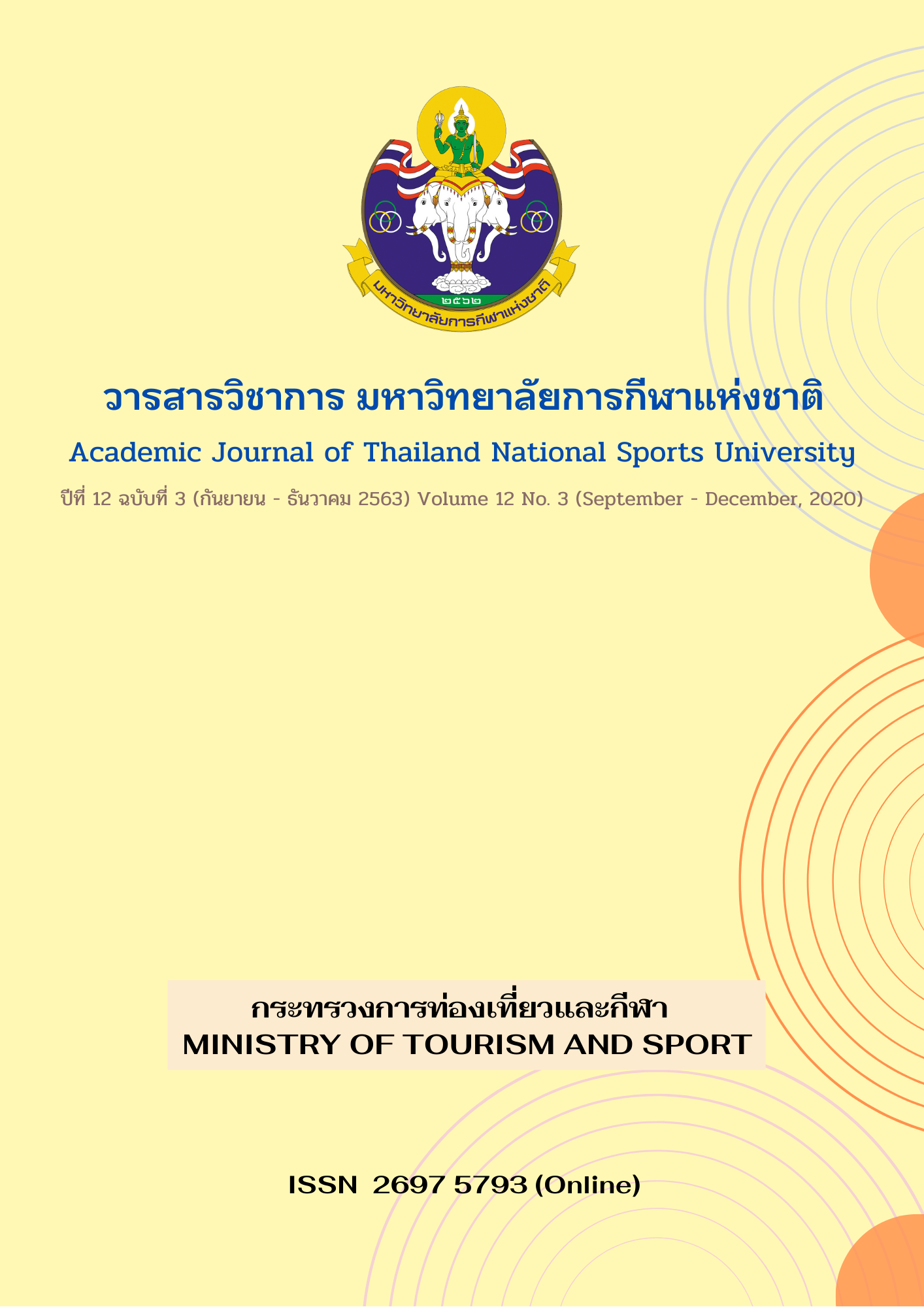DEVELOPMENT OF THE EXERCISE APPLYING THAI WISDOM TO ENHANCE BALANCE OF THE ELDERLY
Main Article Content
Abstract
This research aims to develop the exercise applying Thai wisdom to enhance the balance of the elderly. The research was divided into three phases. The first phase, the model of the exercise applying Thai wisdom to enhance the balance of the elderly was drafted. The second phase, the quality of the model was determined by five professionals and tried out with fifteen elderly aged between 60-70 years old within eight weeks and the third phase, the effects of the model were investigated by quasi-experimental design. The samples were divided into two groups by using simple random sampling with fifteen elderly in the experimental group and fifteen elderly in the control group. The experiment of this research was conducted through eight weeks, three days a week. The instruments used in this research were guidebook of the exercise applying Thai wisdom to enhance the balance of the elderly and the balance test for the elderly. The data were analyzed by mean, standard deviation, mean rank, Wilcoxon Matched-pairs Signed-ranks Test and Mann Whitney U Test at the .05 level of significance.
The results of the study were as follows: 1) The exercise applying Thai wisdom to enhance the balance of the elderly consisted of: 1.1) Frequency of the exercise, three days a week, 1.2) Intensity of the exercise divided into two levels: light level and moderate level, 1.3) Time of the exercise, 30 - 45 minutes, 1.4) Type of the exercise, non-locomotor movement exercise and pause and move exercise, 1.5) Step of the exercise divided into three steps: The first step was warm-up phase with-in 5 - 10 minutes consisting of the 8 motion movement. The second step was workout phase consisting of the 18 motion movement, 1 - 4 weeks with 10 motion movement and 5 - 8 weeks with 8 motion movement. The last step was cool-down phase within 5-10 minutes consisting of the 8 motion movement, 2) After the experiment, the total scores of the exercise applying Thai wisdom to enhance the balance of the elderly in the experimental group were significantly higher than that before the experiment at the level of .05, and the balance of the elderly in experimental group was significantly higher than that in the control group at the level of .05.
Article Details
The published article is a copyright of the Academic Journal of Thailand National Sports University. The passage appeared in each article in this academic journal is a perspective of each author which is not related to the journal. Each author is required to be responsible for all components of his/her own article. If there are any mistakes, each author must be responsible for those mistakes on his/her own.
References
American College of Sports Medicine. (2013). ACSM's guidelines for exercise testing and prescription. Lippincott Williams & Wilkins.
Arsom silp Institute of The Arts. (2010). Thai Sports Wisdom. Bangkok: Plan Printing CO., LTD.
Bishop, D. (2003). “Warm up II”. Sports Medicine, 33(7), 483 - 498.
Chiacchiero, M., & et.al. (2010). “The relationship between range of movement, flexibility, and balance in the elderly”. Topics in Geriatric Rehabilitation, 26(2), 148 - 155.
Department of Physical Education, Ministry of Tourism and Sports. (2012). Aerobic Dance. Bangkok: The Agricultural Co-operative Federation of Thailand. LTD.
Department of the Army. (1998). Physical fitness training (FM) 21-20. Washington, DC: Headquarters, Department of the Army.
Mayuree Tanomsuk. (2006). Developing the exercise model for promotion quality of life of the elderly. (Doctoral dissertation). Kasetsart University.
Miller, D. (2013). Measurement by the physical educator why and how. McGraw-Hill Higher Education.
Ministry of Public Health. (2006). Physical Activity for Elderly with Heart Disease. Bangkok: The Agricultural Co-operative Federation of Thailand, LTD.
National Council on the Aging. (2004). Healthy moves for aging well. Los Angeles: NCOA.
Nattorn Khuntong. (2011). The effect of manora classical dance training on strength and balance of the elders. (Master’s thesis). Srinakharinwirot University.
Paterson, D.H., Jones, G.R. & Ric, C.L., (2007). “Ageing and physical activity: Evidence to develop exercise recommendations for older adults”. Applied Physiology, Nutrition, and Metabolism, 32(S2E), S69 - S108.
Patitta Wongsangtien, Apiwan Ownsungnoen & Rattigan Phusit. (2015). “The effectiveness of the applieed folk art loincloth of the elderly exercise program in Amphur Muang Sukhothai Province”. Academic Journal of Institute of Physical Education, 7(3), 1 - 22.
Prayoch Boonsinsukh & Rumpa Boonsinsukh. (2004). Motor System. Faculty of Allied Health Sciences, Srinakharinwirot University.
Reiman, M. P., & Manske, R. C. (2009). Functional testing in human performance. Human kinetics.
Rikli, R. E., & Jones, C. J. (2001). Senior fitness test manual. Human Kinetics.
Ruth Laohapakdee. (2012). The effects of Mai Plong exercise program on motor ability and social skills of the child with autistic spectrum disorder. (Doctoral dissertation). Chulalongkorn University.
Sarinya Buranasubpasit. (2012). Effects of core muscles training on strength and balance of the elderly. (Master’s thesis). Srinakharinwirot University.
Somboon Inthomya. (2004). A development of the measurement instrument of the bodily-kinesthetic intelligence. (Doctoral dissertation). Chulalongkorn University.
Thanamwong Kritpet & Sitha Phongphibool. (2011). Physiology of exercise. Bangkok: Tiranasar CO., LTD.
The Foundation of Thai Gerontology Research and Development Institute. (2008). Situation of the Thai elderly 2007. Bangkok: TQP CO., LTD. Amarin Printing & Publishing Public Co., Ltd.
The Foundation of Thai Gerontology Research and Development Institute. (2014). Situation of the Thai elderly 2014. Bangkok: TQP CO., LTD. Amarin Printing & Publishing Public Co., Ltd.
The Foundation of Thai Gerontology Research and Development Institute. (2017). Situation of the Thai elderly 2016. Nakornpathom: Printery Co.,Ltd.
Thiwaporn Thaweewannakij et al. (2010). “Balance, fall and quality of life in active and inactive elderly”. Journal of Medical Technology and Physical Therapy, 22(3), 271 - 279.
Wannee Kaemkate. (2012). Research Methodology in Behavioral Sciences. Bangkok: Chulalongkorn University Printing House.
World Health Organization. (2010). Global recommendations on physical activity for health. World Health Organization.


